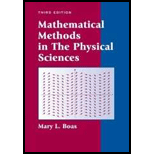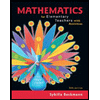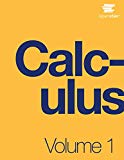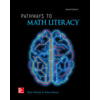1 Infinite Series, Power Series 2 Complex Numbers 3 Linear Algebra 4 Partial Differentitation 5 Multiple Integreals 6 Vector Analysis 7 Fourier Series And Transforms 8 Ordinary Differential Equations 9 Calculus Of Variations 10 Tensor Analysis 11 Special Functions 12 Series Solutions Of Differential Equations; Legendre, Bessel, Hermite, And Laguerre Functions 13 Partial Differential Equations 14 Functions Of A Complex Variable 15 Probability And Statistics expand_more
7.1 Introduction 7.2 Simple Harmonic Motion And Wave Motion; Periodic Functions 7.3 Application Of Fourier Series 7.4 Average Value Of A Function 7.5 Fourier Coefficients 7.6 Dirichlet Conditions 7.7 Complex Form Of Fourier Series 7.8 Other Intervals 7.9 Even And Odd Functions 7.10 An Applications To Sound 7.11 Parseval's Theorem 7.12 Fourier Transforms 7.13 Miscellaneous Problems expand_more
Problem 1P: Following a method similar to that used in obtaining equations (12.11) to (12.14), show that if f(x)... Problem 2P: Do Example 1 above by using a cosine transform (12.15). Obtain ( 12.17); for x0 the 0 to integral... Problem 3P: In Problems 3 to 12, find the exponential Fourier transform of the given f(x) and write f(x) as a... Problem 4P: In Problems 3 to 12, find the exponential Fourier transform of the given f(x) and write f(x) as a... Problem 5P: In Problems 3 to 12, find the exponential Fourier transform of the given f(x) and write f(x) as a... Problem 6P: In Problems 3 to 12, find the exponential Fourier transform of the given f(x) and write f(x) as a... Problem 7P: In Problems 3 to 12, find the exponential Fourier transform of the given f(x) and write f(x) as a... Problem 8P: In Problems 3 to 12, find the exponential Fourier transform of the given f(x) and write f(x) as a... Problem 9P: In Problems 3 to 12, find the exponential Fourier transform of the given f(x) and write f(x) as a... Problem 10P: In Problems 3 to 12, find the exponential Fourier transform of the given f(x) and write f(x) as a... Problem 11P: In Problems 3 to 12, find the exponential Fourier transform of the given f(x) and write f(x) as a... Problem 12P: In Problems 3 to 12, find the exponential Fourier transform of the given f(x) and write f(x) as a... Problem 13P: In Problems 13 to 16, find the Fourier cosine transform of the function in the indicated problem,... Problem 14P: In Problems 13 to 16, find the Fourier cosine transform of the function in the indicated problem,... Problem 15P: In Problems 13 to 16, find the Fourier cosine transform of the function in the indicated problem,... Problem 16P: In Problems 13 to 16, find the Fourier cosine transform of the function in the indicated problem,... Problem 17P: In Problems 17 to 20, find the Fourier sine transform of the function in the indicated problem, and... Problem 18P: In Problems 17 to 20, find the Fourier sine transform of the function in the indicated problem, and... Problem 19P: In Problems 17 to 20, find the Fourier sine transform of the function in the indicated problem, and... Problem 20P: In Problems 17 to 20, find the Fourier sine transform of the function in the indicated problem, and... Problem 21P: Find the Fourier transform of f(x)=ex2/22. Hint: Complete the square in the x terms in the exponent... Problem 22P: The function j1()=(cossin)/ is of interest in quantum mechanics. [It is called a spherical Bessel... Problem 23P: Using Problem 17, show that 01cossind=2,01cossind=4. Problem 24P: (a) Find the exponential Fourier transform of f(x)=ex and write the inverse transform. You should... Problem 25P: (a) Represent as an exponential Fourier transform the function f(x)=sinx,0x,0,otherwise. Hint: Write... Problem 26P: Using Problem 15, show that 01cos2d=2. Problem 27P: Represent each of the following functions (a) by a Fourier cosine integral; (b) by a Fourier sine... Problem 28P: Represent each of the following functions (a) by a Fourier cosine integral; (b) by a Fourier sine... Problem 29P: Represent each of the following functions (a) by a Fourier cosine integral; (b) by a Fourier sine... Problem 30P: Represent each of the following functions (a) by a Fourier cosine integral; (b) by a Fourier sine... Problem 31P: Verify Parsevals theorem (12.24) for the special cases in Problems 31 to 33. f(x) as in Figure 12.1.... Problem 32P: Verify Parsevals theorem (12.24) for the special cases in Problems 31 to 33. f(x) and g() as in... Problem 33P: Verify Parsevals theorem (12.24) for the special cases in Problems 31 to 33. f(x) and g() as in... Problem 34P: Show that if (12.2) is written with the factor 1/2 multiplying each integral, then the corresponding... Problem 35P: Starting with the symmetrized integrals as in Problem 34, make the substitutions =2p/h (where p is... Problem 36P: Normalize f(x) in Problem 21; that is find the factor N so that Nf(x)2=1. Let (x)=Nf(x), and find... format_list_bulleted


 Discrete Mathematics and Its Applications ( 8th I...MathISBN:9781259676512Author:Kenneth H RosenPublisher:McGraw-Hill Education
Discrete Mathematics and Its Applications ( 8th I...MathISBN:9781259676512Author:Kenneth H RosenPublisher:McGraw-Hill Education Mathematics for Elementary Teachers with Activiti...MathISBN:9780134392790Author:Beckmann, SybillaPublisher:PEARSON
Mathematics for Elementary Teachers with Activiti...MathISBN:9780134392790Author:Beckmann, SybillaPublisher:PEARSON
 Thinking Mathematically (7th Edition)MathISBN:9780134683713Author:Robert F. BlitzerPublisher:PEARSON
Thinking Mathematically (7th Edition)MathISBN:9780134683713Author:Robert F. BlitzerPublisher:PEARSON Discrete Mathematics With ApplicationsMathISBN:9781337694193Author:EPP, Susanna S.Publisher:Cengage Learning,
Discrete Mathematics With ApplicationsMathISBN:9781337694193Author:EPP, Susanna S.Publisher:Cengage Learning, Pathways To Math Literacy (looseleaf)MathISBN:9781259985607Author:David Sobecki Professor, Brian A. MercerPublisher:McGraw-Hill Education
Pathways To Math Literacy (looseleaf)MathISBN:9781259985607Author:David Sobecki Professor, Brian A. MercerPublisher:McGraw-Hill Education




